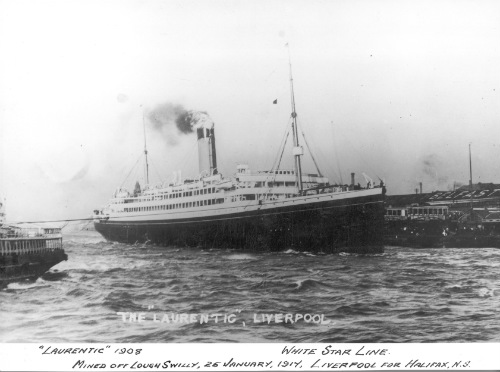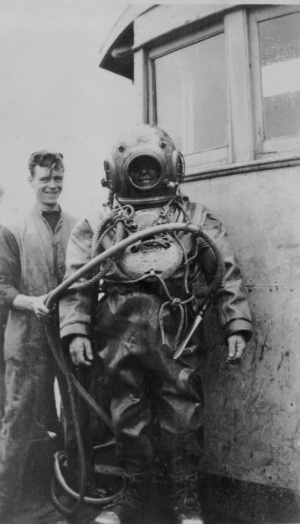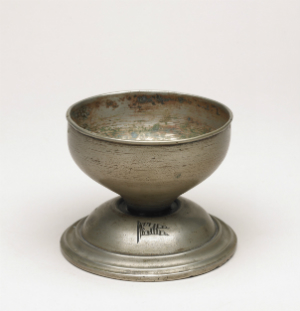
MCR/82/167 Copyright unknown, believed to be expired
As we continue to mark the centenary of the First World War, I wanted to highlight a Liverpool ship that was lost on 25 January 1917.
Laurentic (originally named Alberta) was built in Belfast by Harland & Wolff in 1908 for the Dominion Line. During construction, Alberta and her sister ship Albany were purchased by White Star Line and were renamed Laurentic and Megantic. Laurentic departed on her maiden voyage from Liverpool to Canada in 1909, and over the next few years carried thousands of passengers across the Atlantic.
When war broke out in 1914, Laurentic was requisitioned as a Canadian government troop transport, and later served as an Armed Merchant Cruiser.
In January 1917 she was sailing from Liverpool to Halifax, Nova Scotia, with a secret cargo of 3211 gold ingots worth £5 million (estimated at £300 million today!) as payment for munitions being supplied for the British war effort. On 25 January, Laurentic struck two mines off Lough Swilly in the north of Ireland and sank in less than an hour. There were 475 people on board; 354 lost their lives.

Image courtesy of Colin Stubbington
The loss of life in the sinking was a huge tragedy, but the British Government also suffered a blow with the loss of the gold due to the spiralling costs of the war. They had no choice but to order a salvage operation to attempt to recover as many ingots as possible. A team of divers, led by Commander Guybon Damant, found the wreck and recovered ingots worth £800,000 in 1917. After the war, numerous diving operations led to the retrieval of all but 22 ingots.
In our collection, we have some objects that were salvaged from the wreck during the official dives, including a
metal goblet (made up of two separate items that were fitted together) recovered by Royal Navy diver Richard Stubbington. He was later recognised for his service and was awarded the British Empire Medal. It was donated to
Merseyside Maritime Museum his family.

Accession number MMM.2014.24
You can see it on display in our
Lusitania: life, loss, legacy gallery. It features in a section looking at the crucial role of Liverpool’s merchant ships and seafarers during the First World War.

 MCR/82/167 Copyright unknown, believed to be expired
As we continue to mark the centenary of the First World War, I wanted to highlight a Liverpool ship that was lost on 25 January 1917.
Laurentic (originally named Alberta) was built in Belfast by Harland & Wolff in 1908 for the Dominion Line. During construction, Alberta and her sister ship Albany were purchased by White Star Line and were renamed Laurentic and Megantic. Laurentic departed on her maiden voyage from Liverpool to Canada in 1909, and over the next few years carried thousands of passengers across the Atlantic.
When war broke out in 1914, Laurentic was requisitioned as a Canadian government troop transport, and later served as an Armed Merchant Cruiser.
In January 1917 she was sailing from Liverpool to Halifax, Nova Scotia, with a secret cargo of 3211 gold ingots worth £5 million (estimated at £300 million today!) as payment for munitions being supplied for the British war effort. On 25 January, Laurentic struck two mines off Lough Swilly in the north of Ireland and sank in less than an hour. There were 475 people on board; 354 lost their lives.
MCR/82/167 Copyright unknown, believed to be expired
As we continue to mark the centenary of the First World War, I wanted to highlight a Liverpool ship that was lost on 25 January 1917.
Laurentic (originally named Alberta) was built in Belfast by Harland & Wolff in 1908 for the Dominion Line. During construction, Alberta and her sister ship Albany were purchased by White Star Line and were renamed Laurentic and Megantic. Laurentic departed on her maiden voyage from Liverpool to Canada in 1909, and over the next few years carried thousands of passengers across the Atlantic.
When war broke out in 1914, Laurentic was requisitioned as a Canadian government troop transport, and later served as an Armed Merchant Cruiser.
In January 1917 she was sailing from Liverpool to Halifax, Nova Scotia, with a secret cargo of 3211 gold ingots worth £5 million (estimated at £300 million today!) as payment for munitions being supplied for the British war effort. On 25 January, Laurentic struck two mines off Lough Swilly in the north of Ireland and sank in less than an hour. There were 475 people on board; 354 lost their lives.
 Image courtesy of Colin Stubbington
The loss of life in the sinking was a huge tragedy, but the British Government also suffered a blow with the loss of the gold due to the spiralling costs of the war. They had no choice but to order a salvage operation to attempt to recover as many ingots as possible. A team of divers, led by Commander Guybon Damant, found the wreck and recovered ingots worth £800,000 in 1917. After the war, numerous diving operations led to the retrieval of all but 22 ingots.
In our collection, we have some objects that were salvaged from the wreck during the official dives, including a metal goblet (made up of two separate items that were fitted together) recovered by Royal Navy diver Richard Stubbington. He was later recognised for his service and was awarded the British Empire Medal. It was donated to Merseyside Maritime Museum his family.
Image courtesy of Colin Stubbington
The loss of life in the sinking was a huge tragedy, but the British Government also suffered a blow with the loss of the gold due to the spiralling costs of the war. They had no choice but to order a salvage operation to attempt to recover as many ingots as possible. A team of divers, led by Commander Guybon Damant, found the wreck and recovered ingots worth £800,000 in 1917. After the war, numerous diving operations led to the retrieval of all but 22 ingots.
In our collection, we have some objects that were salvaged from the wreck during the official dives, including a metal goblet (made up of two separate items that were fitted together) recovered by Royal Navy diver Richard Stubbington. He was later recognised for his service and was awarded the British Empire Medal. It was donated to Merseyside Maritime Museum his family.
 Accession number MMM.2014.24
You can see it on display in our Lusitania: life, loss, legacy gallery. It features in a section looking at the crucial role of Liverpool’s merchant ships and seafarers during the First World War.
Accession number MMM.2014.24
You can see it on display in our Lusitania: life, loss, legacy gallery. It features in a section looking at the crucial role of Liverpool’s merchant ships and seafarers during the First World War.
